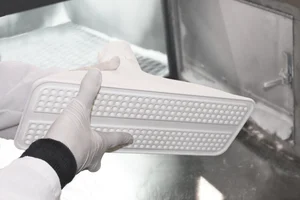To achieve maximum speed without upsetting the center of gravity of the robots, the tool — plus the weight of the product itself — couldn’t weigh more than two kilograms. But the largest load of crackers on the line was 1.5 kilos for a ten-pack. That left only 500 grams with which to design the perfect tool. Once the decision to pursue additive manufacturing was made, Fouad performed a detailed analysis of the many different types of equipment available before deciding on a FORMIGA P 100 system from EOS.
In the case of the major American food manufacturer job for Langen Group, instead of a more traditional metal vacuum plate and shroud (which would have taken months to design and manufacture), Anubis designed a lighter, streamlined set of components that provided four times the gripping force of legacy vacuum grippers. It took only a week to additively manufacture, assemble and test the new tool.
The material used for the main vacuum part was nylon 12 (PA 2200 material from EOS), chosen for its flexibility, ability to sustain crash loads, and because it is certified as USP Class VI approved for food contact.

